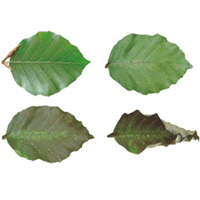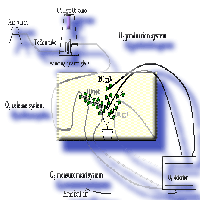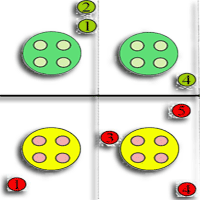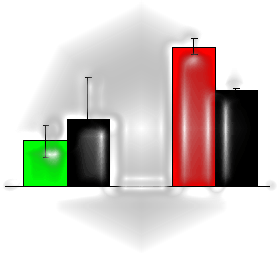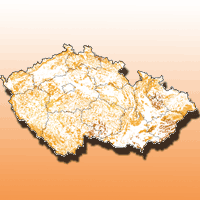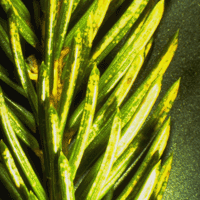
Ozone fumigation effects on the morphology and biomass of Norway spruce (Picea abies L.) saplings
B Serafinaviciute , V Stakenas
iForest - Biogeosciences and Forestry, Volume 2, Issue 1, Pages 15-18 (2009)
doi: https://doi.org/10.3832/ifor0483-002
Published: Jan 21, 2009 - Copyright © 2009 SISEF
Research Articles
Collection/Special Issue: Cost Action E29 Meeting 2008 - Istanbul (Turkey)
Future Monitoring and Research Needs for Forest Ecosystems
Guest Editors: Marcus Schaub (WSL, Birmensdorf, CH)
Abstract
The study examined Norway spruce (Picea abies) saplings morphological and biomass sensitivity to ozone fumigation using closed indoor chambers of controlled environment. 4-year-old potted saplings were exposed to three different ozone concentrations: 80 µg/m3, 160 µg/m3, and 240 µg/m3 (7 h/day, 5 days/week). Half of the saplings were harvested after the exposure, and the second half of the saplings were left in the pots in open field until next autumn. The reaction of the saplings of different timing of bud burst was also investigated. The terminal shoot length and the total current year shoot length of Norway spruce saplings after one month of ozone fumigation were significantly (p<0.05) suppressed in all the treatments comparing to the control saplings. The needles of saplings fumigated with ozone were smaller than the needles of control saplings. No significant changes of the biomass of different fractions of Norway spruce saplings were determined right after the fumigation, as well as, in 14 month after the cessation of the fumigation. Norway spruce saplings of early and late timing of bud burst reacted differently to ozone fumigation during the active growth period. The formation of new needles and shoots of the saplings of late bud burst stage was more suppressed comparing to the saplings of the early bud burst stage. The results suggest that the generatively younger organs during their formation are more susceptible to ozone stress. The differences of the needle age between ozone affected and control saplings decreased in one year after the end of fumigation keeping affected Norway spruce saplings in the open field and thus indicating the start of the recovery process.
Keywords
Ozone fumigation, Norway spruce saplings, Shoot morphology, Biomass
Authors’ Info
Authors’ address
V Stakenas
Lithuanian Forest Research Institute, Ecology Department, Girionys, LT-53101 Kaunas distr. (Lithuania)
Corresponding author
Paper Info
Citation
Serafinaviciute B, Stakenas V (2009). Ozone fumigation effects on the morphology and biomass of Norway spruce (Picea abies L.) saplings. iForest 2: 15-18. - doi: 10.3832/ifor0483-002
Paper history
Received: Mar 13, 2008
Accepted: Dec 09, 2008
First online: Jan 21, 2009
Publication Date: Jan 21, 2009
Publication Time: 1.43 months
Copyright Information
© SISEF - The Italian Society of Silviculture and Forest Ecology 2009
Open Access
This article is distributed under the terms of the Creative Commons Attribution-Non Commercial 4.0 International (https://creativecommons.org/licenses/by-nc/4.0/), which permits unrestricted use, distribution, and reproduction in any medium, provided you give appropriate credit to the original author(s) and the source, provide a link to the Creative Commons license, and indicate if changes were made.
Web Metrics
Breakdown by View Type
Article Usage
Total Article Views: 48951
(from publication date up to now)
Breakdown by View Type
HTML Page Views: 40338
Abstract Page Views: 3444
PDF Downloads: 4138
Citation/Reference Downloads: 44
XML Downloads: 987
Web Metrics
Days since publication: 6176
Overall contacts: 48951
Avg. contacts per week: 55.48
Citation Metrics
Article Citations
Article citations are based on data periodically collected from the Clarivate Web of Science web site
(last update: Mar 2025)
Total number of cites (since 2009): 2
Average cites per year: 0.12
Publication Metrics
by Dimensions ©
Articles citing this article
List of the papers citing this article based on CrossRef Cited-by.
References
Otbor i razmnozhenije pliusovyx derevjev jeli obyknovennoj [Selection and reproduction of spruce plus-trees]. Avtoreferat disertacii, Tallin, Estonia, pp. 30. [in Russian]
Gscholar
Measuring, modelling and testing ozone exposure, flux and effects on vegetation in southern European conditions - What does not work? A review from Italy. Environmental Pollution 146: 648-659.
CrossRef | Gscholar
Can plant traits be used to explain differences in ozone sensitivity between native european plant species? In: “Critical levels for ozone - Level II” (Fuhrer J, Achermann B eds). Environmental Documentation No. 115, Swiss Agency for Environment, Forest and Landscape, Bern, Switzerland, pp. 83-87.
Gscholar
Egles genetiniai tyrimai ir selekcija Lietuvoje [Fungal genetic research and selection in Lithuania]. Vilnius, Lithuania, pp. 359. [in Lithuanian]
Gscholar
Ozone effects on forest vegetation in Europe. In: “Effects of air pollution on forest health and biodiversity in forests of the Carpathian mountains” (Szaro RC, Bytnerowicz A, Ozslányi J eds). Series I: Life and Behavioural Sciences - Vol. 345. IOS Press, Amsterdam-Berlin-Oxford-Tokyo-Washington, pp. 43-49.
Online | Gscholar
Impacts of air pollution and climate change on forest ecosystems - Emerging research needs. TheScientificWorldJournal 7 (S1): 1-8.
CrossRef | Gscholar
Effects of air pollution on forest health and biodiversity in forests of the Carpathian mountains: an overview. In: “Effects of air pollution on forest health and biodiversity in forests of the Carpathian mountains” (Szaro RC, Bytnerowicz A, Ozslányi J eds). Series I: Life and Behavioural Sciences - Vol. 345. IOS Press, Amsterdam-Berlin-Oxford-Tokyo-Washington, pp. 3-10.
Gscholar
Manual on methodologies and criteria for harmonised sampling, assessment, monitoring and analysis of the effects of air pollution on forests. Programme Co-ordinating Center, UN/ECE, Hamburg, Geneva, pp. 2-40.
Gscholar
The condition of forests in Europe. 2004 Executive report. UNECE, Geneva, pp. 51.
Gscholar
O fenologii drevesnyx porod v Karelii i metodie uchiota intensivnosti cvetenija i plodonoshenija sosni i jieli. Voprosi liesovedenija i liesnoj entomologii v Karelii. Moskva-Leningrad, pp. 42-48.
Gscholar

